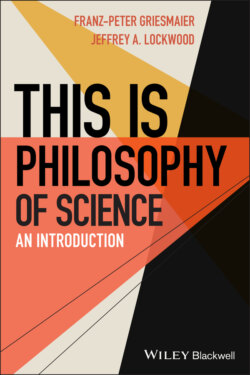Читать книгу This is Philosophy of Science - Franz-Peter Griesmaier - Страница 25
2.2 Basic Evidence and Derived Evidence 2.2.1 What We See
ОглавлениеOne question that many philosophers, as well as some scientists, have asked (at least implicitly) is this: What should be regarded as ultimate or basic evidence? In other words, what is our evidential bedrock? This question might seem strange at first. Clearly, it is information about the world and what is happening in it that should serve as the ultimate evidence to be used in the construction and confirmation of our empirical theories. For example, a physician’s observation that her patient exhibits Koplik spots is (a piece of) the ultimate evidence for her diagnosis that the patient has the measles. Or, to take another example, my gas gauge’s needle position is my evidence for the belief that I have enough gas in the tank to get home easily. In light of these examples, it would seem that ordinary observations of the world, along with measurements, constitute our basic evidence.
However, things are not altogether that easy. Consider the expression “information about the world” more closely. In what form do we access this information, and how do we process it? One might think that the observation of, say, Koplik spots is unproblematic. Looking at her patient’s gums, the physician simply observes the presence of those spots. But is that really the best way to describe the situation? That it might not be becomes clear when we imagine a person who has never heard of Koplik spots, or of the measles, and who has never seen those “spots” before. Clearly, to him, what he observes are some lesions or blisters on the gums, but not Koplik spots. A lot of theoretical knowledge goes into observing Koplik spots as opposed to observing mere discolored tissue. Pushing this line of thought even further, an extraterrestrial life form, for example, one who hasn’t seen gums, or humans, before, won’t even see spots of tissue discoloration. It might describe its observation as that of a reddish surface with small whitish regions, if indeed it has the concepts of “whitish” and “reddish.” What this seems to show is that what we directly observe are not things of a certain kind (such as human gums) carrying indicators of a disease (such as Koplik spots), but rather, what we directly observe are distributions of colors and edges in our visual field.
The same point is perhaps even more obvious in the example involving my gas gauge. Clearly, I need to know what the instrument is supposed to show before I can use the needle position as evidence for any hypotheses about the amount of gas left in my car, and thus as evidence for being able to get home safely. (Many of us have probably experienced confusion about a brand-new car’s instrumentation.) Furthermore, I already need to know what roles needles play in an instrument, and even what instruments in general are, viz., measuring devices of various kinds. None of this information can be gleaned directly from what we actually observe: distributions of colors, surfaces, and the like.
Considerations such as these have led many to propose that the ultimate, or basic, evidence for all of our hypotheses about the world are various distributions of colors, edges, sounds, and the like, which result from impacts of the world on our sense organs. As the American philosopher Willard van Orman Quine famously put it:
“[…] the only information that can reach our sensory surfaces from external objects must be limited to two-dimensional optical projections and various impacts of air waves and some gaseous reactions in the nasal passages and a few kindred odds and ends. How […] could one hope to find out about that external world from such meager traces?”
(Roots of Reference, 1974, 2)
Quine raises two issues here. First, he claims that our contact with the world is constituted by the impact of various forms of information, embodied in various physical systems, on our sense organs. Second, he rightly notices that it is somewhat surprising that we can have knowledge of the world on the basis of such “meager traces.” We won’t discuss the second issue now, which is related to the question of skepticism and realism, but relegate it to Chapter 12. Instead, we will briefly discuss the view that the ultimate evidence is to be found in distributions of various physical properties and/or magnitudes in one’s sensory field. The result of our discussion will be to dismiss this view as a fruitful account of scientific evidence. We will also see that the view possibly arises from equating, rightly or wrongly, evidential with causal relations.
